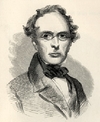





Sir John Watson Gordon
He was born John Watson in Edinburgh in 1788, the eldest son of Captain Watson, R.N., a cadet of the family of Watson of Overmains, in the county of Berwick. He was educated specially with a view to joining the Royal Engineers.
He entered as a student in the government school of design, under the management of the Board of Manufactures. He showed a natural aptitude for art, and his father was persuaded to allow him to adopt it as his profession. Captain Watson was himself a skilful draughtsman, and his brother George Watson, afterwards president of the Royal Scottish Academy, was a highly-
In 1808 John exhibited a picture "The Lay of the Last Minstrel" at the Lyceum in Nicolson Street, Edinburgh -
One of the earliest of his famous sitters was Sir Walter Scott, who sat for a first portrait in 1820. Then came JG Lockhart in 1821; Professor Wilson, 1822 and 1850, two portraits; Sir Archibald Alison, 1839; Dr Chalmers, 1844; a little later De Quincey, and Sir David Brewster, 1864.
Among his most important works may be mentioned the 1st Marquess of Dalhousie; Sir Alexander Hope (1835); Lord President Hope; and Dr Chalmers. These, unlike his later works, are generally rich in colour. The full length of Dr Brunton (1844), and Dr Lee, the principal of the university (1846), mark a modification of his style, which ultimately resolved itself into extreme simplicity, both of colour and treatment.
During the last twenty years of his life he painted many distinguished Englishmen who came to Edinburgh to sit. And it is significant that David Cox, the landscape painter, on being presented with his portrait, subscribed for by many friends, chose to go to Edinburgh to have it executed by Watson Gordon, although he neither knew the painter personally nor had ever before visited the country.
Among the portraits painted during this period, in what may be termed his third style, are De Quincey; General Sir Thomas Macdougall Brisbane; the Prince of Wales, Lord Macaulay, Sir M. Packington, Lord Murray, Lord Cockburn, Lord Rutherford and Sir John Shaw-
These latter pictures are mostly clear and grey, sometimes showing little or no positive colour, the flesh itself being very grey, and the handling extremely masterly, though never obtruding its cleverness. He was very successful in rendering acute observant character. A good example of his last style, showing pearly flesh-
Gordon was one of the earlier members of the Royal Scottish Academy, and was elected' its president in 1850; he was at the same time appointed limner for Scotland to the queen, and received the honour of knighthood. Since 1841 he had been an associate of the Royal Academy, and in 1851 he was elected a royal academician.
A word or two about the painters

home | about | art collection | links | contact
webmaster jd@pppbm.net website & contents* ©chantryfinearts 2011 terms | privacy policy
*Some content has been obtained from the WorldWideWeb and is all believed to be in the Public Domain and copyright free
if this is not the case please notify the webmaster and the material will be checked and removed if appropriate